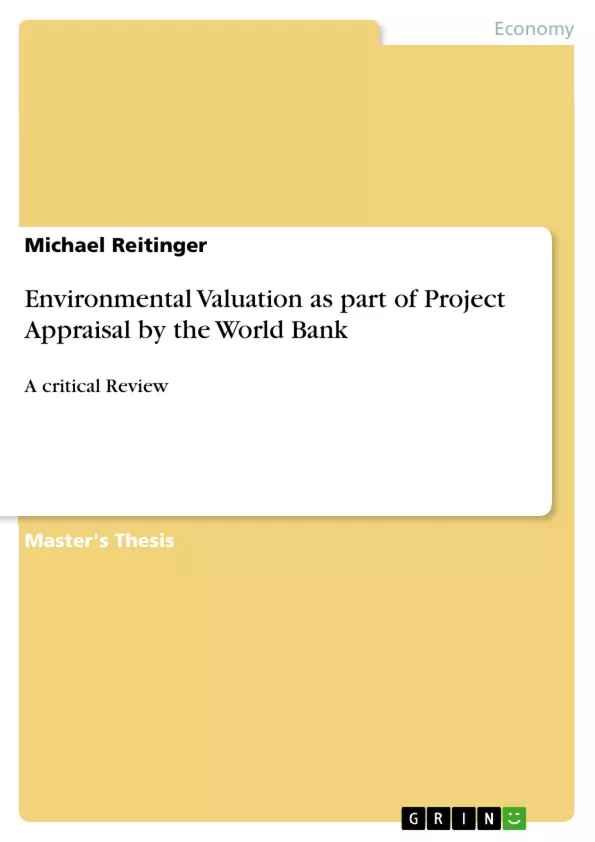In face of scarce resources and growing population, sustainability became the term used to consider the needs of future generations in the decision making process referring projects. The World Bank, as one of the major players in the field of development research and practice, aggregates information from different areas in the project appraisal document (PAD) in order to allow for sustainability. One of the approaches used to measure environmental impacts of a project is economic valuation of environmental goods and services. The results of this approach flow into the cost benefit analysis, which is part of the economic analysis. Although substantial critique has been expressed over the last decades, environmental valuation and costbenefit analysis are considered sensible tools in the context of decision making over project funding. This is especially the case because of tremendous development of these techniques over the last decades.
This study shows that the World Bank, as one of the leading institutions in the world, treats this topic from two different perspectives. First, there is the theoretical side. Here the World Bank sets out ideal procedures, under their rules and guidelines, and publishes papers and reports with respect to further development of underlying methods. The aim here is to allow for measurement of total social welfare, or in other words measurement of the complete picture of environmental costs and benefits associated with a project. Second there is the practical side, were the World Bank adjusts environmental valuation techniques in order to understand the most important costs and benefits associated with a project, where measurement of the total social welfare of a project is not the target. In this case the aim is to collect sufficient information to allow making a funding decision, rather than understanding the complete picture. This impression is caused by findings from the case study which showed that during project appraisal obvious environmental benefits have not been measured.
Inhaltsverzeichnis (Table of Contents)
- Chapter One Introduction
- Chapter Two Literature Review and Methodological Framework
- Chapter Two One - Project Appraisal
- Chapter Two Two - Cost-Benefit Analysis
- Chapter Two Three - Valuation of Environmental Goods and Services
- Chapter Three Valuation of Environmental Goods and Services by the World Bank
- Chapter Three One - Relevant World Bank Guidelines
- Chapter Three Two - Case Study: Croatia Coastal Reconstruction & Protection Project
- Chapter Four Analysis of the Environmental Valuation at the World Bank
- Chapter Four One - Analysis of the Case Study
- Chapter Four Two - What the Case Study tells about the World Bank
- Chapter Five Conclusion
Zielsetzung und Themenschwerpunkte (Objectives and Key Themes)
This dissertation critically examines the World Bank's approach to environmental valuation as part of project appraisal. It aims to analyze the Bank's theoretical guidelines and practical implementation of environmental valuation techniques. The study explores the extent to which these methods contribute to achieving sustainable development goals.
- The role of environmental valuation in project appraisal and its impact on sustainability.
- The World Bank's theoretical framework for environmental valuation and its consistency with practical applications.
- Analysis of a case study to illustrate the World Bank's approach to environmental valuation in practice.
- Evaluation of the strengths and weaknesses of the World Bank's environmental valuation methodology.
- The implications of the findings for the future of environmental valuation within development projects.
Zusammenfassung der Kapitel (Chapter Summaries)
Chapter One provides an introduction to the topic of environmental valuation and its relevance in the context of project appraisal and sustainable development.
Chapter Two presents a literature review of existing theoretical frameworks and methodological approaches for environmental valuation. It explores the concept of project appraisal, cost-benefit analysis, and the valuation of environmental goods and services.
Chapter Three delves into the World Bank's approach to environmental valuation, analyzing relevant guidelines and policies. The chapter also features a case study of the Croatia Coastal Reconstruction & Protection Project, examining how environmental valuation was implemented in practice.
Chapter Four critically analyzes the environmental valuation practices employed in the case study, evaluating the effectiveness of the World Bank's methods and highlighting potential limitations.
Schlüsselwörter (Keywords)
This dissertation focuses on the critical analysis of environmental valuation within the context of project appraisal by the World Bank. Key terms include contingent valuation method, cost-benefit analysis, environmental valuation, project appraisal, sustainability, and World Bank. The study examines the World Bank's theoretical frameworks and practical applications, focusing on the effectiveness and limitations of environmental valuation techniques in achieving sustainable development goals.
- Quote paper
- Michael Reitinger (Author), 2011, Environmental Valuation as part of Project Appraisal by the World Bank, Munich, GRIN Verlag, https://www.grin.com/document/351008



